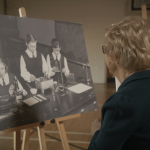Alison ten Bohmer was searching for a solution to COVID isolation when she first encountered Pietra Fitness.
“The hour-long session went by in a flash and I was hooked,” she told The B.C. Catholic about participating in a DVD session of the bodily prayer program during lockdown.
The experience was life-changing. “For me, its benefits have been numerous: a deeper, consistent prayer life, fewer aches and pains, improved posture, confidence, bodily awareness, and breathing capacity,” said the parishioner of St. Mary’s parish in Chilliwack.

After some soul-searching, she decided to train as a Pietra Fitness instructor. She is certified to teach beginner, intermediate, and advanced classes, as well as “chair” classes for people with low mobility. She also runs a Pietra Kids Program at St. Mary’s Elementary.
Pietra Fitness is a Catholic exercise program that promotes mental wellness and body-mind connection. It involves poses and stretching, a meditative environment, and prayer, although it is not, as instructors point out, “Catholic yoga.”
It was founded in 2008 after yoga was suggested to its founder Karen Barbieri as a solution to chronic pain. Yoga effectively solved the problem, but Barbieri was uncomfortable with its Eastern spiritual roots. With the help of a spiritual director, Barbieri was certified as a yoga instructor and developed Pietra (the Italian word for rock as a Catholic/Christian alternative.
During their training, Pietra Fitness instructors are taught to respect yoga and its relationship to Buddhism and Hinduism but to understand its differences. Because yoga derives each pose and sequence from Eastern spirituality, they have real spiritual consequences.
“Pietra Fitness instructors are not to use the same language or posture sequences as yoga because it can symbolize an offering or represent a physical prayer to Eastern Gods,” ten Bohmer said.
“By participating in a yoga class with other religious icons present or following an instructor’s cues for engaging in Eastern meditation, a Catholic may not even realize it is contrary to our Church’s teachings,” she said.
Even when the spiritual risk is minimal, the functional relationship between a yoga pose and a person’s spiritual orientation can be relevant.

For example, the prayer pose in yoga – hands pressed together with wrists at right angles – focuses the practitioner inwards, which isn’t spiritually beneficial and could be considered counterproductive in a Catholic context, where the ultimate goal of meditative prayer is to orient one’s devotion toward God. In Pietra Fitness, Catholics hold their hands together with their wrists at obtuse angles to point themselves toward God.
While such formal distinctions help differentiate Pietra Fitness from general fitness routines and new-age spiritual practices, its theological underpinnings are what makes it tick. The fundamental concern of Pietra Fitness is to regard the body as a temple of the Holy Spirit and a home for the Eucharist.
“St. Augustine wrote, ‘We become what we eat,’“ said ten Bohmer. “Therefore, every time we take part in a Eucharistic celebration, we become a living, breathing tabernacle for our Lord to reside!”
That reflection can be a gentle reminder that we should be intentional in how we treat our bodies as “beautiful tools to offer our praise, thanks, and glory to God,” she said.
Your entire body in prayer
Neither the promise of health benefits nor seeing those happy people on yoga studio posters accounted for my long-standing curiosity about yoga.
It was because under its boring, secular health routine whitewash, yoga offers a bizarre yet esoteric promise that, with the right movements, I could find spiritual enlightenment.
Despite my interest, I never mustered enough motivation to actually try yoga. Still, I was excited when it was suggested I write a story about Pietra Fitness, a similar health program that was Catholic. One thing led to another, and Chilliwack Pietra Fitness instructor Alison ten Bohmer offered to run a men’s session so I could write about it for The B.C. Catholic.
Upon arrival at St. Mary’s, a waiver was waiting for me to confirm that I understood Pietra Fitness is not, in fact, “Catholic yoga.” I’ll admit I was disappointed. I wanted Pietra Fitness to be weird and spiritual, not some Catholic facsimile of a bland, secular workout routine.
Thankfully as I read down the page it became clear that the designers of Pietra Fitness had taken yoga quite seriously – seriously enough that it was off-limits.
There has been a trend in the Church for a few years to downplay the spiritual nature of yoga. If you some priests whether a Catholic can participate in yoga, the response is usually that yoga – just stretching – is fine if you don’t get into any of the spiritual content that some yoga instructors teach.

This feels like a cheap response. Either the way we use our bodies matters, or it doesn’t. Why bother with genuflecting, sitting, standing, kneeling, standing again, or prostrating ourselves during liturgy if our physical actions don’t convey serious truth about our relationship to God and the cosmos? Our posture and actions aren’t superficial. They communicate deep meaning that isn’t necessarily expressed through spoken language.
The first time I bowed to press my head against the ground before the Blessed Sacrament was a fundamentally different experience than when I simply genuflected. The physical action directed my emotional and mental energy toward God in a way that genuflecting did not.
Consider meditation. It’s undeniable that a person kneeling creates a different impression than if that person were sitting cross-legged in a lotus position. The body’s orientation is a crucial part of the prayer experience in this context, and this relationship doesn’t necessarily flow only one way. It’s not a perfect formulation, but perhaps instead of saying a person kneels when they pray, maybe it’s just as true to say that someone prays when they kneel.
With all this in mind, participating in Pietra Fitness was as bizarre as it was peaceful and profound. When the session started, ten Bohmer told us we would never empty our minds; we would only shift our focus. In this sense, Pietra Fitness was no different than any other form of Catholic meditation. The Rosary offers the same implicit guidance by focusing the prayer on the life of Christ through the experiences of the Virgin Mary. But the Pietra session definitely wasn’t the Rosary.
I don’t know how to explain it, but it feels different involving your entire body in prayer. I felt a bit like Charlie Brown following waltz steps on the floor. Still, even with the limited insight of a single session, I could feel something beyond the awkwardness.
Every time we were instructed in some movement, I had to concentrate on the experience in a way that prayers usually don’t require. It also didn’t take any effort to stay focused.
For the next few days after the session, I thought more about the physicality of reality and how I interacted with myself. Especially at Mass, the liturgical postures and gestures had a different cadence. They weren’t so routine now that I had connected movement with prayer in a different context.
Doing our Pietra session, ten Bohmer taught me that there is always room for something new. What I used to think of prayer wasn’t wrong, but perhaps it was smaller than it needed to be. Christ illuminates all of creation, and Pietra Fitness is a reminder that maybe there are still many shadows left to explore.



